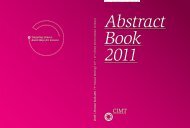Abstract Book 2010 - CIMT Annual Meeting
Abstract Book 2010 - CIMT Annual Meeting
Abstract Book 2010 - CIMT Annual Meeting
You also want an ePaper? Increase the reach of your titles
YUMPU automatically turns print PDFs into web optimized ePapers that Google loves.
054 Bloetz | Cellular therapy<br />
Allo-reactivity to HLA class II mismatch alleles in CD4+<br />
T-cell subsets<br />
Andrea Blötz 1 , Eva Distler 1 , Elke Schnürer 1 , Simone Thomas 1 , Ugur Sahin 1 , Matthias Theobald<br />
1 , Wolfgang Herr 1<br />
1 Dept. of Medicine III – Hematology & Oncology, University Medical Center, Mainz, Germany<br />
98<br />
In allogeneic hematopoietic stem cell transplan-<br />
tation (allo-HSCT), allo-reactive T lymphocytes<br />
of donor origin recognize antigens expressed on<br />
patient-derived leukemia cells, thereby mediating<br />
the beneficial graft-versus-leukemia effect. If alloantigens<br />
are expressed on non-hematopoietic recipient<br />
tissues, donor T cells also induce graft-versushost<br />
disease (GvHD). Since HLA mismatch alleles<br />
represent major targets of allo-reactive T lymphocytes,<br />
patient and donor are usually matched for<br />
the class I molecules HLA-A, -B, -C, and for the<br />
class II molecules HLA-DRB1 and -DQB1, in order<br />
do reduce the risk of GvHD. The HLA-DPB1 locus,<br />
however, is still ignored in donor selection. Interestingly,<br />
clinical studies have demonstrated that<br />
disparities at HLA-DQB1 and distinct HLA-DPB1<br />
alleles do not adversely affect the outcome of allo-<br />
HSCT. Because HLA class II is predominantly expressed<br />
on hematopoietic cells, allo-reactive CD4+<br />
donor T cells recognizing HLA-DQB1 or permissive<br />
HLA-DPB1 mismatch alleles may primarily target<br />
patient leukemic and hematopoietic cells, while<br />
sparing non-hematopoietic recipient tissues. In this<br />
ongoing study we analyze the allo-reactive potential<br />
of CD4+ T-lymphocyte subsets by stimulating<br />
them in vitro against single HLA class II mismatch<br />
alleles. For that purpose, CD4+ peripheral blood T<br />
lymphocytes of healthy donors are sorted by flow<br />
cytometry according to the expression or absence<br />
of the differentiation markers CD45RA, CD45RO,<br />
CD62L and CCR7. As standard antigen-presenting<br />
cells for class II-mismatch stimulations, we use the<br />
HLA-deficient cell line K562 upon electroporation<br />
with in vitro transcribed RNA coding for the alpha<br />
and beta chains of single HLA class II molecules<br />
(HLA-DQ: DQA1-010201/DQB1-060201; HLA-DR:<br />
DRA1-0101/DRB1-0701). This procedure results in<br />
transient HLA expression for up to one week with<br />
strongest staining intensity (>80% positive cells)<br />
24h after electroporation. In addition, transfectants<br />
do not lose HLA class II expression upon freezing,<br />
thawing and irradiation cycles. In a first series of<br />
experiments, sorted CD4 T-cell subsets of 3 healthy<br />
donors were stimulated weekly with mismatched<br />
K562/HLA-DR or -DQ transfectants, respectively,<br />
and were tested for allo-reactivity 5 days after the<br />
first (d12) and second (d19) restimulation in IFN-γ<br />
ELISPOT assays. The strongest allo-HLA II reactivity<br />
was detected in the CD45RApos and CD62Lpos<br />
as well as in the CD45ROneg CD4+ subsets, in contrast<br />
to the corresponding counterpart fractions,<br />
confirming that allo-reactivity can be found mainly<br />
in naive and central memory T cells. Alloreactivity<br />
of the CCR7pos and CCR7neg cell fractions varied<br />
considerably. In all cases, anti-HLA class II reactivity<br />
of CD4 populations could be blocked by monoclonal<br />
antibodies to the respective HLA class II<br />
molecule used for stimulation. Proliferation did not<br />
show clear differences between individual CD4+<br />
T-cell subsets. In summary, we show herein that<br />
the transient expression of HLA class II molecules<br />
in K562 cells by RNA electroporation is a rapid and<br />
efficient approach to detect and stimulate allo-HLA<br />
class II reactive CD4+ T-cell responses. The strongest<br />
class II mismatch reactivity was found in the<br />
naive and central memory CD4+ T-cell subsets.<br />
This approach based on K562 cells and HLA class<br />
II RNA as „off-the-shelf” reagents allows to rapidly<br />
generate CD4+ T cells with reactivity to single allo-<br />
HLA-DQ/DP alleles, which may be of potential use<br />
in adoptive immunotherapy of leukemias.



